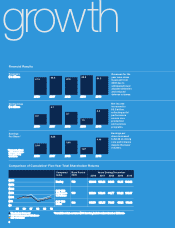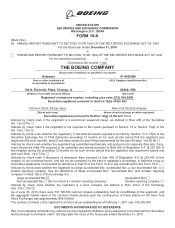Boeing 2010 Annual Report Download - page 19
Download and view the complete annual report
Please find page 19 of the 2010 Boeing annual report below. You can navigate through the pages in the report by either clicking on the pages listed below, or by using the keyword search tool below to find specific information within the annual report.Commercial aircraft pricing is based in part on escalation formulas established well in advance of
delivery and is therefore subject to factors beyond our control. Price escalation provisions in our sales
contracts are designed to adjust for economic fluctuations between the contract date and aircraft
delivery, a period which can span many years. As a result, aircraft pricing generally consists of a fixed
amount as modified by a price escalation formula using pre-defined factors. Our revenue estimates are
based on current expectations with respect to these escalation formulas. Changes in escalation
amounts can significantly impact revenues and operating margins in our Commercial Airplanes
business.
We derive a significant portion of our revenues from a limited number of major commercial airlines. We
can make no assurance that any customer will purchase additional products or services from us after
our contract with the customer ends. In addition, fleet decisions, consolidation or financial challenges
involving any of our major commercial airline customers could significantly reduce our revenues and
limit our opportunity to generate profits from those customers.
Our commercial aircraft production rates could change. Production rate reductions could cause us to
incur disruption and other costs and result in infrastructure costs being allocated to a smaller quantity
of airplanes, all of which could reduce our profitability. The introduction of a new aircraft program and/
or higher orders for our aircraft could lead to production rate increases in order to meet the delivery
schedules. Failure to successfully implement any production rate changes could lead to extended
delivery commitments, and depending on the length of delay in meeting delivery commitments,
additional costs and customers rescheduling their deliveries or terminating their related contract with
us.
The profitability of our commercial aircraft development programs depends upon a variety of
factors, which are subject to unique risks.
We are currently engaged in the demanding flight testing and certification phases of program
development on both the 787-8 and 747-8 Freighter aircraft. These airplanes have highly complex
designs, utilize exotic materials and require extensive coordination and integration with supplier
partners. As a result, our ability to deliver aircraft on time, meet contractual performance requirements
and achieve program profitability is subject to significant risks.
Operational issues, including delays or defects in supplier components, the inability to efficiently and
cost-effectively incorporate design changes into production aircraft, and aircraft performance issues,
could result in additional expenses or lower program revenues. For example, in 2009 we determined
that three of the six 787 flight test aircraft could not be sold due to the inordinate amount of work that
would be required to prepare the aircraft for sale. As a result, we reclassified $2.7 billion from inventory
to research and development expense. If we determine that one or more of the other flight test aircraft
will not be sold, we may incur additional charges. In addition, flight testing and certification delays or
supplier or other operational challenges that impact our ability to achieve our targeted production rates
may result in aircraft delivery delays and higher costs to complete. For example, on January 18, 2011,
we announced that the expected date of first delivery of our 787 Dreamliner had been moved to the
third quarter of 2011 due to a combination of flight testing delays, supplier challenges and other issues
common to commercial aircraft development programs. Our inability to deliver aircraft to our customers
in a timely manner could result in order cancellations or other significant financial exposures, or could
otherwise reduce the profitability of our Commercial Airplanes business. We continue to work with our
customers and suppliers to assess the specific impact of schedule changes and otherwise to ensure
that our aircraft meet customer expectations.
Looking beyond entry into service for the 787-8 and 747-8 Freighter, we continue to work toward
improving production efficiencies and supplier performance, incorporating design changes into aircraft
7
























